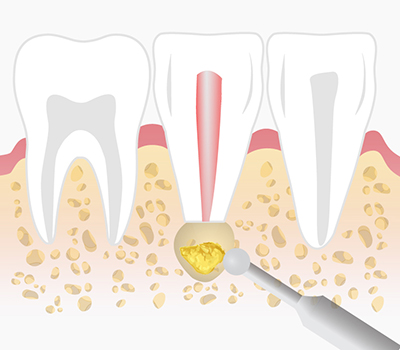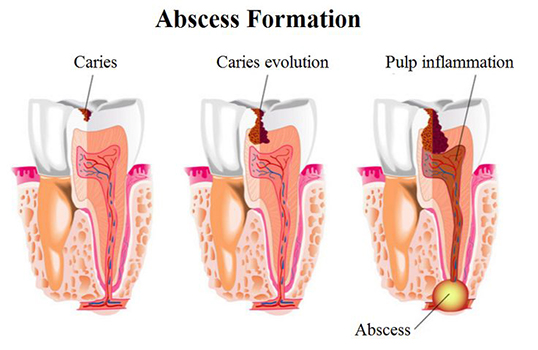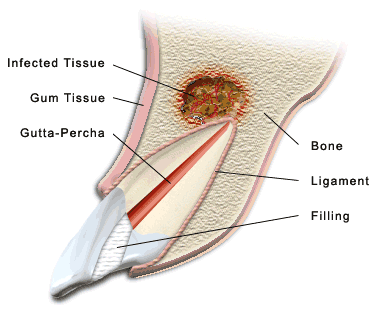Do you have a tooth that has already had root canal treatment and is still having issues? This tooth may be a candidate for a ‘root end procedure’ or ‘apical surgery.’ St. Lawrence Dentistry has saved many teeth through this beneficial technique.

‘Root end procedure’ is an umbrella term for three separate procedures done in conjunction. These are apical curettage, apicoectomy, and retrofill. These are simple procedures to treat dental abscesses at the end of a root. Dr. Hawryluk Jr. performs apical procedures (end of root) on teeth that exclusively have had root canal treatment or are going to have root canal treatment the same day as this procedure. A dental abscess means that bacteria are present in both a tooth as well as in the bone surrounding a tooth (peri-radicular abscess). In this environment, the immune system cannot dissipate the bacteria because there is no blood supply in the tooth (and hence no immune cells). Bacteria in the tooth replicate and spill into the surrounding bone. A root canal procedure treats the bacteria inside the tooth and corks off the end of the root. This procedure alone is usually enough to allow the bacteria in the bone to dissipate. When the root canal procedure siphons off the root end, the immune system usually has the power to control the bacteria in the bone, and it begins to dissipate. However, in a minority of circumstances, this is not the case, and this is when the root end procedures can be useful.

If bacteria persist at the end of the root despite root canal treatment, there are two options: redoing the root canal or doing a root end procedure. Root canal retreatment would be an ideal choice if there were a glaring deficiency in the root canal done. Missed channels or a short root fill are both indications to redo a root canal treatment. However, if the initial root canal treatment is already ideal, then usually there is no point in repeating it, and going direct to a root end procedure is the most reasonable. One main advantage of a root end procedure over redoing a root canal to address ongoing symptoms is the root end procedure directly removes any bacteria at the end of the root.
On the other hand, repeating a root canal will only create an environment in which the bacteria may begin to dissipate. Everything about your specific situation is under consideration when deciding the best treatment option for you. Dr. Hawryluk will thoroughly review all treatment options and address if the apical procedure is right for you.

Apicoectomy Procedure:
The first step in performing a root end procedure is gently pushing back the gingiva (gum) in the area of the abscess. Often, when the bone is exposed, the dentist will see a tiny opening leading to a dental abscess through the bone. Magnification is crucial, and Dr. Hawryluk utilizes the Globa Dental Microscope for ultimate precision. Once the abscess area is found, the thin veneer of bone around the abscess is gently trephined away until it is completely exposed. Apical curettage is performed, which is the removal of all the abscess tissue. It generally looks like a gelatinous tissue that is easy to spot with the microscope. The part of the root which has been bathing in the abscessed tissue is trimmed (apicoectomy), and then the remainder of the root end is packed with filling material (retrofill). Ultrasonic instruments accomplish the root-end preparation. Dr. Hawryluk Jr. uses the Satelec P5 Newton unit with special retro preparation tips for this process. Placement of MTA or IRM at the end of the root to finish the procedure which research has found is the most effective retrofill material.
Root end procedures are a precious technique as it saves teeth which would have otherwise needed removal. Although the process is technique-sensitive and advanced equipment is required, it is a relatively simple procedure and usually has a subsequent comfortable recovery. If you would like to learn more about this technique and live in the Mississauga/Toronto area, please call St. Lawrence Dentistry.



